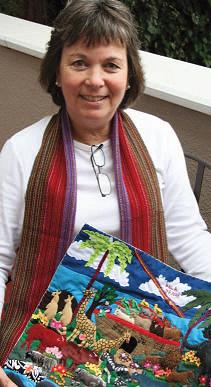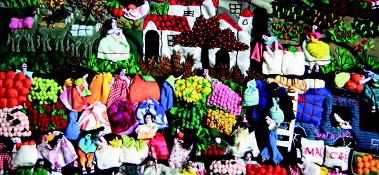Student Stories
Stitching Hope and Beauty in Pamplona Alta

For these cuadros, Davis asked the women to sew scenes that expressed their hopes and dreams. One artist sewed pictures of animals — llamas, giraffes, and others — grazing in a lush botanica or garden paradise. Another woman sewed a street in her home village, stitching on a red car she could someday rent out to support her retirement. One cuadro, a commissioned piece, displays dozens of figures in colorful skirts dancing to celebrate the Feast of the Virgin of Candelaria — trees and tiny flowers blooming in riotous color across the fabric in marked contrast to the harsh, grey, garbage-strewn slum where the women of the collective live.
“These women are co-creators with God.”
“All my life I’ve been interested in putting art, faith, and justice together,” says Davis, a former art teacher and museum curator from Billings, Montana.
In what she calls an “attempt to link these three ideas,” she earned master’s degrees in education, religious studies, and art history. Then she found the GTU program in Art and Religion.
“With this project I’m using ethnography as a methodology while linking precepts of liberation theology,” Davis says. “Art, creativity, and beauty for me are connected to faith, poverty, politics, and the life of the women of Pamplona Alta.”
Davis is interested in the art of ordinary people. The Peruvian women carefully unravel threads, cut up old clothing, and sew them into new pieces, expressions of culture and beauty. There are stories in the salvaged scraps of cloth — of strikes, violence in the pueblos, or marches for peace. There often is a political thread — many of the older women and their families fled the countryside in the 1970s and 1980s, caught between right-wing government forces fighting left-wing Shining Path guerillas. And the women first stitched cuadros after seeing Chilean versions honoring those who disappeared in the 1970s under the Pinochet regime.
 Davis has organized several exhibits called “Picturing Paradise,” showcasing the cuadros of Pamplona Alta. They’ve hung in the Princeton Theological Seminary’s Erman Gallery, at the University of St. Thomas in Minnesota, the Basilica of Saint Mary in Minneapolis, and at Bryn Mawr Presbyterian Church in Pennsylvania. In spring 2009, they’ll be on view at the Dominican School of Philosophy &Theology, a GTU member school.
Davis has organized several exhibits called “Picturing Paradise,” showcasing the cuadros of Pamplona Alta. They’ve hung in the Princeton Theological Seminary’s Erman Gallery, at the University of St. Thomas in Minnesota, the Basilica of Saint Mary in Minneapolis, and at Bryn Mawr Presbyterian Church in Pennsylvania. In spring 2009, they’ll be on view at the Dominican School of Philosophy &Theology, a GTU member school.
“Showing the work educates people about the lives of these women and what we hold in common with them, and promotes sales of the pieces, a significant source of income for the cooperative,” Davis says.
Thanks to her GTU courses, Davis balances a commitment to activism with the idea of justice in her relationship with these Third World women. On her most recent trip to Pamplona Alta, she brought her laptop to show the collective the presentation she gives in First World countries, including a June 2008 international conference on inclusive museums held in the Netherlands. She also gave the women disposable cameras and asked them to photograph images they thought were important to include in her presentations.
“I’m looking for God and finding God right here in Pamplona Alta,” Davis says. “These women highlight the key aspects of what ‘good work’ is all about — community, faith, simplicity, and the ability to create beauty in a powerful way. They are co-creators with God.”
To learn more about Pamplona Alta and purchase cuadros, visit www.convida.org.
